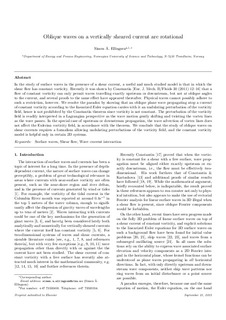| dc.contributor.author | Ellingsen, Simen Andreas Ådnøy | |
| dc.date.accessioned | 2019-11-13T11:02:11Z | |
| dc.date.available | 2019-11-13T11:02:11Z | |
| dc.date.created | 2016-01-20T13:44:09Z | |
| dc.date.issued | 2016 | |
| dc.identifier.citation | European journal of mechanics. B, Fluids. 2016, 56 156-160. | nb_NO |
| dc.identifier.issn | 0997-7546 | |
| dc.identifier.uri | http://hdl.handle.net/11250/2628175 | |
| dc.description.abstract | In the study of surface waves in the presence of a shear current, a useful and much studied model is that in which the shear flow has constant vorticity. Recently it was shown by Constantin (2011) that a flow of constant vorticity can only permit waves travelling exactly upstream or downstream, but not at oblique angles to the current, and several proofs to the same effect have appeared thereafter. Physical waves cannot possibly adhere to such a restriction, however. We resolve the paradox by showing that an oblique plane wave propagating atop a current of constant vorticity according to the linearised Euler equation carries with it an undulating perturbation of the vorticity field, hence is not prohibited by the Constantin theorem since vorticity is not constant. The perturbation of the vorticity field is readily interpreted in a Lagrangian perspective as the wave motion gently shifting and twisting the vortex lines as the wave passes. In the special case of upstream or downstream propagation, the wave advection of vortex lines does not affect the Eulerian vorticity field, in accordance with the theorem. We conclude that the study of oblique waves on shear currents requires a formalism allowing undulating perturbations of the vorticity field, and the constant vorticity model is helpful only in certain 2D systems. | nb_NO |
| dc.language.iso | eng | nb_NO |
| dc.publisher | Elsevier | nb_NO |
| dc.rights | Attribution-NonCommercial-NoDerivatives 4.0 Internasjonal | * |
| dc.rights.uri | http://creativecommons.org/licenses/by-nc-nd/4.0/deed.no | * |
| dc.title | Oblique waves on a vertically sheared current are rotational | nb_NO |
| dc.type | Journal article | nb_NO |
| dc.type | Peer reviewed | nb_NO |
| dc.description.version | acceptedVersion | nb_NO |
| dc.source.pagenumber | 156-160 | nb_NO |
| dc.source.volume | 56 | nb_NO |
| dc.source.journal | European journal of mechanics. B, Fluids | nb_NO |
| dc.identifier.doi | 10.1016/j.euromechflu.2015.11.002 | |
| dc.identifier.cristin | 1318770 | |
| dc.description.localcode | © 2016. This is the authors’ accepted and refereed manuscript to the article. This manuscript version is made available under the CC-BY-NC-ND 4.0 license http://creativecommons.org/licenses/by-nc-nd/4.0/ | nb_NO |
| cristin.unitcode | 194,64,25,0 | |
| cristin.unitname | Institutt for energi- og prosessteknikk | |
| cristin.ispublished | true | |
| cristin.fulltext | postprint | |
| cristin.qualitycode | 1 | |

